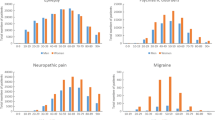Abstract
Background
Estimates of the prevalence of diseases can be affected by changes in the awareness of the diseases. The emergence of new drugs may affect the awareness of the diseases among patients and physicians. We have reported that the rate of increase in the number of drugs available was a statistically significant factor correlated with the rate of increase in the number of patients diagnosed thereafter. We aimed to investigate the impact of the emergence of new drugs on the number of patients diagnosed with individual intractable diseases and to determine the types of drugs that had a greater impact on these changes.
Methods
The number of patients, the number of drugs indicated and diagnostic and certification criteria for the diseases from 2004 to 2013 were collected from publicly available data. We compared the annual rate of increase in the number of patients before and after the emergence of new drugs. Factors affecting the annual rate of increase in the number of patients were investigated.
Results
The annual rate of increase in the number of patients was statistically significantly increased after the emergence of new drugs (Average increase of 0.9% per year, Wilcoxon signed-rank test; p = 0.035). The emergence of drugs with new active substances and drugs with new mechanisms of action were statistically significant factors correlated with the increase in the number of patients.
Conclusion
The emergence of new drugs, especially drugs with new active substances and drugs with new mechanisms of action, was associated with an increase in the number of patients diagnosed thereafter.

Similar content being viewed by others
References
Lundbäck B, Rönmark E, Jönsson E, et al. Incidence of physician-diagnosed asthma in adults-a real incidence or a result of increased awareness? Report from The Obstructive Lung Disease in Northern Sweden Studies. Respir Med. 2001;95(8):685–92.
Lipton RB, Scher AI, Kolodner K, et al. Migraine in the United States: epidemiology and patterns of health care use. Neurology. 2002;58(6):885–94.
Turner PJ, Gowland MH, Sharma V, et al. Increase in anaphylaxis-related hospitalizations but no increase in fatalities: an analysis of United Kingdom national anaphylaxis data, 1992–2012. J Allergy Clin Immunol. 2015;135(4):956–63.
Winterstein AG, Gerhard T, Shuster J, et al. Utilization of pharmacologic treatment in youths with attention deficit/hyperactivity disorder in Medicaid database. Ann Pharmacother. 2008;42(1):24–31.
Olfson M, Blanco C, Wang S, et al. National trends in the mental health care of children, adolescents, and adults by office-based physicians. JAMA Psychiat. 2014;71(1):81–90.
Oka T, Narukawa M. Increased availability of drugs is correlated with the number of patients diagnosed thereafter: data analysis of 45 intractable diseases. J Clin Pharm Ther. 2021;46(5):1319–25.
Kanatani Y, Tomita N, Sato Y, et al. National registry of designated intractable diseases in Japan: present status and future prospects. Neurol Med Chir (Tokyo). 2017;57(1):1–7.
Funding
The authors declare that no funds, grants, or other support were received.
Author information
Authors and Affiliations
Contributions
Substantial contributions to the conception or design of the work; or the acquisition, analysis, or interpretation of data for the work (TO); and drafting the work or revising it critically for important intellectual content (TO, MN); and final approval of the version to be published (TO, MN); and agreement to be accountable for all aspects of the work in ensuring that questions related to the accuracy or integrity of any part of the work are appropriately investigated and resolved (TO).
Corresponding author
Ethics declarations
Conflict of interest
The authors have no relevant financial or non-financial interests to disclose.
Additional information
Publisher's Note
Springer Nature remains neutral with regard to jurisdictional claims in published maps and institutional affiliations.
Rights and permissions
Springer Nature or its licensor holds exclusive rights to this article under a publishing agreement with the author(s) or other rightsholder(s); author self-archiving of the accepted manuscript version of this article is solely governed by the terms of such publishing agreement and applicable law.
About this article
Cite this article
Oka, T., Narukawa, M. Emergence of New Drugs for Intractable Diseases is Associated with an Increase in the Number of Patients Diagnosed Thereafter with Those Intractable Diseases. Ther Innov Regul Sci 57, 70–78 (2023). https://doi.org/10.1007/s43441-022-00440-x
Received:
Accepted:
Published:
Issue Date:
DOI: https://doi.org/10.1007/s43441-022-00440-x




